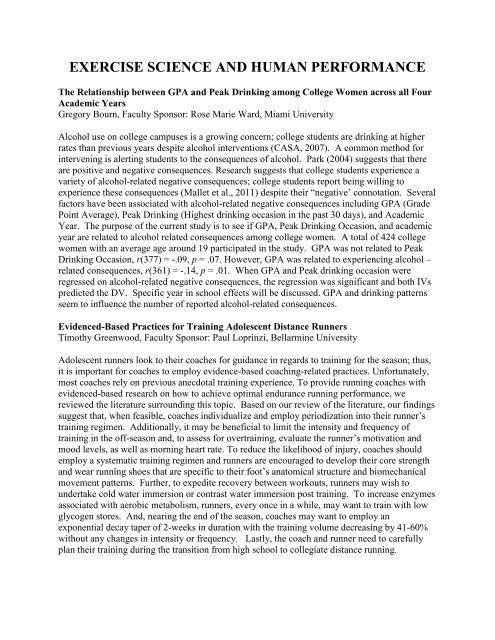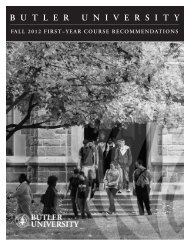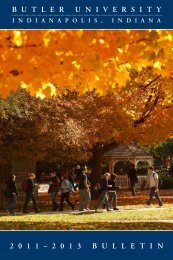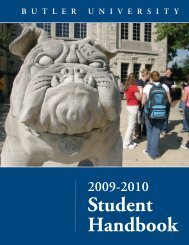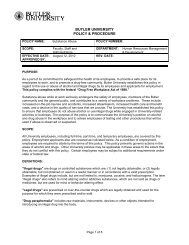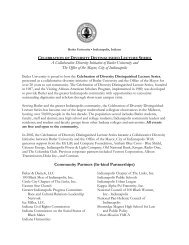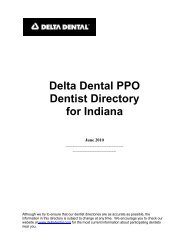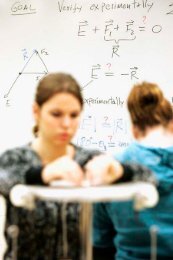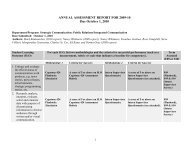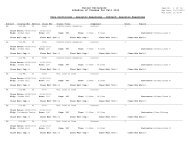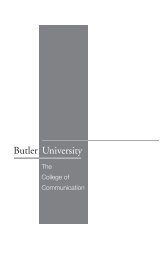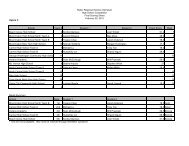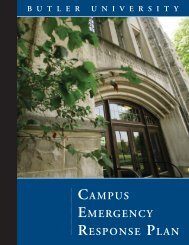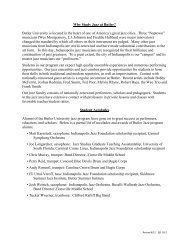Anthropology - Butler University
Anthropology - Butler University
Anthropology - Butler University
You also want an ePaper? Increase the reach of your titles
YUMPU automatically turns print PDFs into web optimized ePapers that Google loves.
EXERCISE SCIENCE AND HUMAN PERFORMANCE<br />
The Relationship between GPA and Peak Drinking among College Women across all Four<br />
Academic Years<br />
Gregory Bourn, Faculty Sponsor: Rose Marie Ward, Miami <strong>University</strong><br />
Alcohol use on college campuses is a growing concern; college students are drinking at higher<br />
rates than previous years despite alcohol interventions (CASA, 2007). A common method for<br />
intervening is alerting students to the consequences of alcohol. Park (2004) suggests that there<br />
are positive and negative consequences. Research suggests that college students experience a<br />
variety of alcohol-related negative consequences; college students report being willing to<br />
experience these consequences (Mallet et al., 2011) despite their “negative’ connotation. Several<br />
factors have been associated with alcohol-related negative consequences including GPA (Grade<br />
Point Average), Peak Drinking (Highest drinking occasion in the past 30 days), and Academic<br />
Year. The purpose of the current study is to see if GPA, Peak Drinking Occasion, and academic<br />
year are related to alcohol related consequences among college women. A total of 424 college<br />
women with an average age around 19 participated in the study. GPA was not related to Peak<br />
Drinking Occasion, r(377) = -.09, p = .07. However, GPA was related to experiencing alcohol –<br />
related consequences, r(361) = -.14, p = .01. When GPA and Peak drinking occasion were<br />
regressed on alcohol-related negative consequences, the regression was significant and both IVs<br />
predicted the DV. Specific year in school effects will be discussed. GPA and drinking patterns<br />
seem to influence the number of reported alcohol-related consequences.<br />
Evidenced-Based Practices for Training Adolescent Distance Runners<br />
Timothy Greenwood, Faculty Sponsor: Paul Loprinzi, Bellarmine <strong>University</strong><br />
Adolescent runners look to their coaches for guidance in regards to training for the season; thus,<br />
it is important for coaches to employ evidence-based coaching-related practices. Unfortunately,<br />
most coaches rely on previous anecdotal training experience. To provide running coaches with<br />
evidenced-based research on how to achieve optimal endurance running performance, we<br />
reviewed the literature surrounding this topic. Based on our review of the literature, our findings<br />
suggest that, when feasible, coaches individualize and employ periodization into their runner’s<br />
training regimen. Additionally, it may be beneficial to limit the intensity and frequency of<br />
training in the off-season and, to assess for overtraining, evaluate the runner’s motivation and<br />
mood levels, as well as morning heart rate. To reduce the likelihood of injury, coaches should<br />
employ a systematic training regimen and runners are encouraged to develop their core strength<br />
and wear running shoes that are specific to their foot’s anatomical structure and biomechanical<br />
movement patterns. Further, to expedite recovery between workouts, runners may wish to<br />
undertake cold water immersion or contrast water immersion post training. To increase enzymes<br />
associated with aerobic metabolism, runners, every once in a while, may want to train with low<br />
glycogen stores. And, nearing the end of the season, coaches may want to employ an<br />
exponential decay taper of 2-weeks in duration with the training volume decreasing by 41-60%<br />
without any changes in intensity or frequency. Lastly, the coach and runner need to carefully<br />
plan their training during the transition from high school to collegiate distance running.


